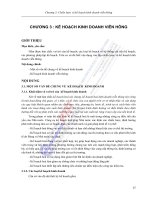Crisis intervention strategies chapter 3 4
Bạn đang xem bản rút gọn của tài liệu. Xem và tải ngay bản đầy đủ của tài liệu tại đây (254.49 KB, 40 trang )
Chapter 3 & 4 Basic Crisis Assessment & Intervention Skills
1
TRIAGE ASSESSMENT SYSEM
•
•
•
Assesses severity of clients presenting crisis
situation
Assistance for gaining sense of direction for
helping client cope with the dilemma
Integrated problem-solving process
2
SEVEN STEP ASSESSMENT PROCESS
1.
2.
3.
Predispositioning/e
ngaging/initiating
contact
Problem
exploration
Providing support
4.
5.
6.
7.
3
Examining
alternatives
Making plans
Obtaining
commitment to action
Follow-up
LISTENING (PSYCHOLOGICAL FIRST
AID)
•
•
•
•
•
•
Caring support
Empathic responding
Concrete information and assistance
Reuniting social support systems
Survival needs (Maslow)
Nonintrusive (Not time for ‘cure’ or ‘fix’)
4
SAFETY
•
Minimizing psychological and physical danger
•
•
•
Client
Self
Others
5
STEP 1: PREDISPOSITIONING/ENGAGING/INITIATING
CONTACT
•
•
From the clients perspective
Active Listening/Attending Skills (observing,
understanding, and responding)
•
•
•
•
•
•
•
•
Respect
Without judgment
Caring
Empathy
Genuineness
Acceptance or positive regard
Use open ended questions
Attending to verbal and non-verbal messages
6
STEP 2: EXPLORING THE PROBLEM
•
•
Defining the crisis
From the clients point of view
7
STEP 3: PROVIDING SUPPORT
•
•
•
Caring emotional support
Non possessive
Informational support
•
•
In order to make good decisions
Instrumental support
•
Basic needs
8
ACTING (STRATEGIES)
•
•
•
Nondirective
Collaborative
Or Directive (if needed)
9
STEP 4: EXAMINING ALTERNATIVES
•
Exploring choices and options
•
•
•
•
Immediate Situational Supports (people)
Coping mechanism (actions or resources)
Positive and constructive thinking patterns
(reframing to alter the clients view)
Look for a few that are appropriate and
realistic to discuss with client (not too many)
10
STEP 5: MAKING PLANS (ACTION STEPS)
•
•
•
•
•
•
•
•
To restore clients emotional equilibrium
Easy for client to own and understand
Short term (minutes, hours, days)
Identifying additional resources and coping tools
Systematic problem solving
Concrete and positive
Things client can ‘do now’
Collaborative with since of control and autonomy
11
STEP 6: OBTAINNG COMMITMENT
•
•
•
•
•
•
Brief and simple
Ask client to verbalize the plan
Written and signed (if severe)
Handshake
Free, voluntary and believed to be doable
Honest, direct and appropriate commitment
•
Before termination
12
CLIENT FUNCTIONING
•
•
Generally, no time for formal diagnosis or
assessment instruments
Goal: to assist client with pre-crisis
•
•
Equilibrium
Mobility
13
TERMS
•
•
•
Equilibrium (emotion or mental
balance/stability)
Disequilibrium (Lack or destruction of
balance/stability)
Mobility (autonomous change or coping of
moods, conditions, influences)
•
•
Flexible and adaptable
Immobility (Not capable of mobility)
14
ASSESSMENT HELPS DETERMINE:
•
•
•
•
•
Severity of crisis and client functioning
Client’s current emotional status
Client’s alternatives and resources
Client’s level of lethality
How well counselor is doing in assisting client
to equilibrium and mobility
15
CLIENT FUNCTIONING
•
Affective State (feeling or emotional tone)
•
•
Behavioral Functioning (activity level)
•
•
Out of control, withdrawn, detached,
overemotional, etc.
The sooner the better
Cognitive State (thinking patterns)
•
•
Realistic, consistent, rational, exaggerating, etc.
Able to positively reframe
16
ASSESSMENT FORMS
•
•
•
Often take up too much time
May be inappropriate for client level of functioning
TAF (Triage Assessment Form)
•
•
Fairly rapid and valid
Versions
•
•
•
Law enforcement
Students
Civilians
17
PSYCHOBIOLOGICAL ASSESSMENT IN CRISIS
•
•
•
•
Evidence that neurotransmitters play a role in
affective, behavioral, and cognitive
functioning during (and sometimes after)
crisis
Can cause residual and long term changes
Impact of mental health medication
Impact of legal and illegal drugs
18
REQUIRING COUNSELORS TO ATTEMPT TO ASSESS:
•
•
•
•
•
Prior trauma
Psychopathology
Use, misuse, or abuse of drugs
And is there a correlations with the current
crisis/problem
Referral may be needed
19
ASSESSING EMOTIONAL FUNCTIONING
Duration of Crisis
1.
•
•
Current reservoir of emotional stamina
2.
•
Helplessness, hopelessness, ‘no future’
Clients Ecosystem variables
3.
•
4.
Acute/situational (one time/short term)
Chronic (recurring, long-term or transcrisis)
Communication system, cultural mores,
accessibility, economic status, etc
Developmental Stage
20
FACILITATIVE AFFECTIVE
ASSESSMENT
•
Data gleaned about the client are used as a
part of the ongoing helping process.
21
ASSESSING ALTERNATIVES/RESOURCES
•
•
•
•
•
List of referral resources
Brainstorming
Realistic options
Impediments to progress?
Institutional, social, vocational, personal
strengths or support systems =people
22
SUMMARY OF ASSESSMENT
•
•
•
•
•
•
Taking available information and making
meaningful sense out of it.
Quickly evaluate
Be flexible
Assessment is central and continuous process
Continue until pre-crisis state is obtained
Even then, in many cases…. Only the acute
phase is then over!
23
LISTENING SKILLS
•
•
•
•
•
•
•
•
•
•
Open-ended questions
Closed-ended questions
Restatement and Summary clarification
Owning Feelings (counselor focus)
Disowned statements and pretending
Conveying understanding (of situation)
Value judgments (of situation)
Positive reinforcement (of behavior)
Personal integrity and setting limits
Assertion statements
24
9 BASIC STRATEGIES
Creating Awareness
1.
•
Facing denied, repressed feelings, thoughts and
behaviors
Allowing Catharsis
2.
•
Allowing full feelings, venting, talking, crying in
safe environment (caution: best for those who
struggle with feelings)
Providing Support
3.
•
Validations, affirmation, without dependence
25









